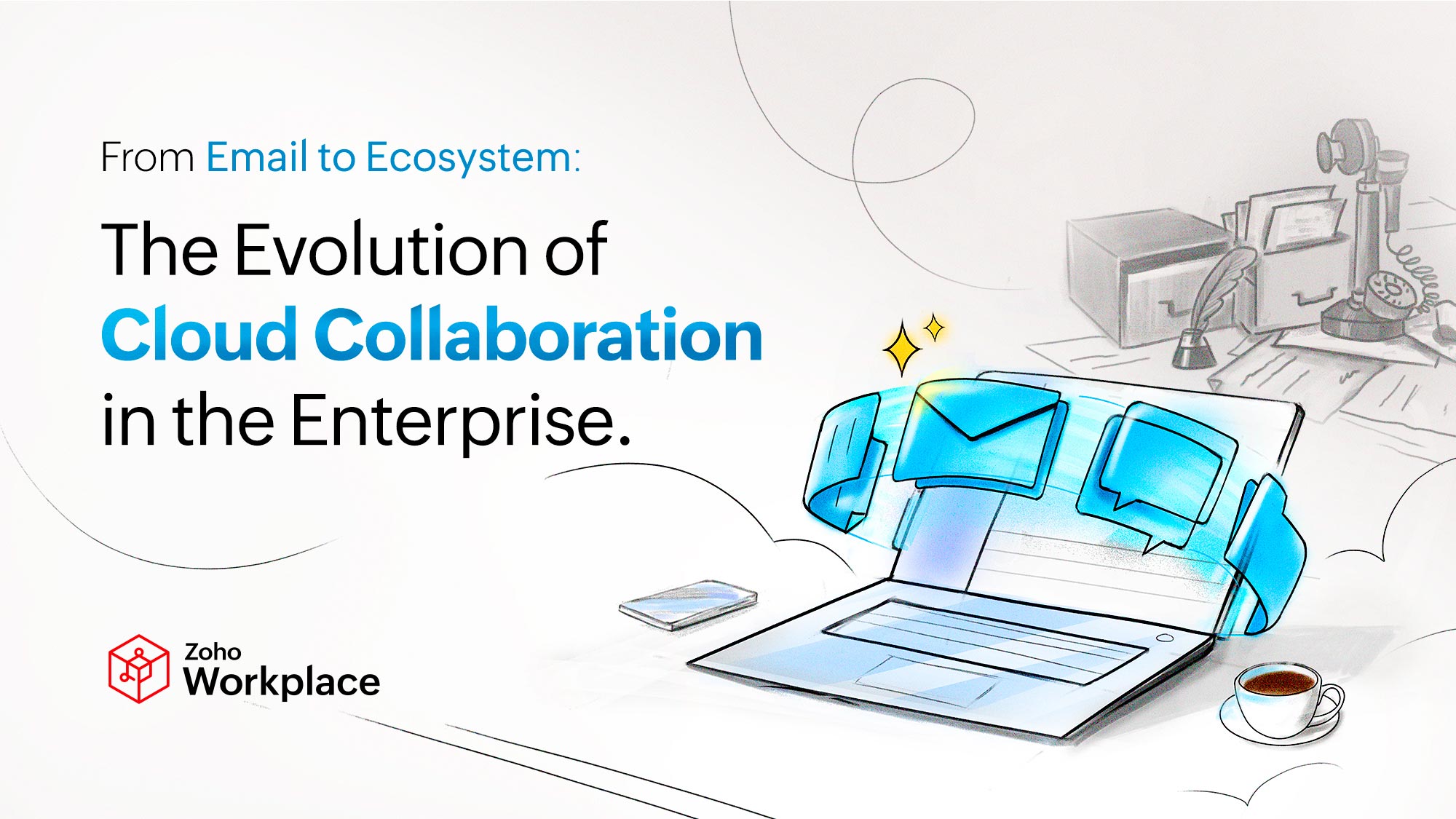- HOME
- All Products
- Beyond email: How cloud ecosystems are transforming work
Beyond email: How cloud ecosystems are transforming work
- Published : September 30, 2025
- Last Updated : September 30, 2025
- 285 Views
- 5 Min Read
It wasn’t that long ago that business communication involved putting memos in the mail slot, playing games of phone tag, or walking across the office to stop by a coworker’s desk.
Now, to employees who are used to sending a quick instant message or video calling someone across the globe, those methods seem almost unbearably cumbersome and time-consuming.
That’s because the workplace hasn’t been a stranger to disruptive technologies that have fundamentally changed the way people work. Collaboration has never stood still—and the evolution is far from over.
Let’s take a look back at how digital collaboration got started and explore why modern organizations are continuing to refine the way teams connect, share, and keep work moving.

Looking back: The early days of digital collaboration
While faxes and switchboards had their heydays, any conversation about revolutionary office technologies is likely to focus on email. Development started back in the 1970s, but it didn’t become mainstream in workplaces and homes until the mid-to-late 1990s.
Seemingly overnight, offices moved away from mail and printed interoffice memos to these seemingly futuristic electronic messages. “We can now transmit a 64-page document from Irvine to England, the Netherlands, or West Germany in eight minutes—quite an improvement over the minimum mail delivery times of three days,” marveled Jeff Krause, a former supervisor at an engineering and management firm, in a 1980 issue of Popular Science.
Email was groundbreaking on its own, but it also opened the door for other digital collaboration tools like:
- Calendar and scheduling tools: Microsoft Outlook and Lotus Notes included digital calendars and meeting invites with email, quickly replacing paper calendars and phone-based scheduling.
- Shared drives and file servers: As attachments clogged up inboxes, IT pushed for shared folders and network drives so teams could store and retrieve documents digitally.
- Instant messaging: Internal chat systems gave teams faster and less formal communication than email.
- Web conferencing tools: Platforms like WebEx and GoToMeeting gained traction as remote meetings and screen sharing became necessary companions to email.
- Document collaboration platforms: By the late aughts, Google Docs and Dropbox gained popularity as ways to work on shared files without endless email attachments.
Email adoption laid the foundation for the use of a variety of tools, with each one addressing a specific need and serving as a building block of today’s approach to digital collaboration.
Servers, siloes, and stress: The many challenges of isolated collaboration tools
Emails, calendars, file servers, instant messaging, and more all helped teams work faster and more efficiently. But they’re no longer transformative at work—they’re table stakes.
However, for as useful as each tool is on its own, organizations are quickly realizing that using them in isolation introduces several challenges, including:
- Siloed workflows: Having separate tools for separate functions may seem intuitive, but it actually makes it harder for people to see the full picture and can lead to more miscommunications, missed messages, and duplicate work.
- Limited integrations: When tools don’t connect, people need to transfer data between systems manually. This creates more busy work and increases the risk of errors.
- Reduced access: On-premises servers or fragmented platforms can make it difficult for remote or hybrid team members to access the files and information they need. With hybrid work remaining the predominant work arrangement, easy access from anywhere is more important than ever.
- Security gaps: Managing multiple, disconnected tools increases the risk of inconsistent permissions, compliance issues, and data breaches.
- Tool fatigue: An explosion of disparate chat, video, storage, and project apps is often draining for workers, with an alarming 90% of employees admitting they feel overwhelmed by the number of software tools they use. Too many tools are also expensive for organizations to purchase and maintain.
So what’s the solution? More and more organizations are adopting yet another revolutionary workplace technology to address these pain points: the cloud.
Siloed to seamless: The rise of cloud adoption at work
As cutting-edge as email was in the workplace, the cloud is perhaps even more transformative, with research from MIT citing the cloud as one of the top disruptive technologies of our time. Cloud adoption has also been rapid, and it’s nearly universal at this point. A reported 98% of companies globally use the cloud in some capacity.
Adopting the cloud means different things to different organizations. But, generally, it involves moving applications, data, and workflows from on-premises servers to internet-based platforms. Rather than relying on physical infrastructure and localized software, teams can access email, documents, calendars, chat, and project management tools from anywhere and on any device.
Needless to say, much of the cloud’s appeal is that it directly addresses the many frustrations of disconnected systems by knocking down silos, reducing manual work, and streamlining collaboration.
Beyond the cloud: Why ecosystems are the next step
But simply moving to the cloud isn’t the end of the story. Even with cloud tools in place, many organizations still find themselves juggling multiple apps, workflows, and platforms. Research indicates that the average desk worker uses up to 11 apps to complete their tasks.
So, forward-thinking companies are going a step further by moving beyond individual cloud applications to fully integrated ecosystems that connect every aspect of their work in one environment. An estimated 53% of organizations are getting on board and actively consolidating redundant applications.
The shift to this more holistic approach offers plenty of benefits:
- Lower costs: Businesses with unified platforms reduced their software costs by 40% to 60% while also improving team productivity.
- Business growth: In the same research, companies using integrated systems grew 19% faster than those with fragmented tools.
- Tighter security: Ecosystems centralize security, permissions, and updates, making them easier to monitor and maintain.
By bringing email, chat, file storage, meetings, and project management into a single connected platform, cloud ecosystems support seamless, accessible, and real-time collaboration.
Making your move: Transitioning from disconnected tools to a connected ecosystem
For organizations ready to go beyond cloud adoption, the shift to a fully integrated ecosystem doesn’t need to be overwhelming. Here are a few practical tips to get started:
- Audit your current tools: Make a list of all of the apps and platforms you use and look for overlaps, redundancies, or tools that are completely unused.
- Prioritize integrations: Look for platforms that can centralize multiple functions rather than maintaining standalone apps.
- Consolidate thoughtfully: Reduce your number of apps gradually (rather than doing a huge overnight overhaul) and keep your teams informed and trained along the way.
- Monitor and iterate: Regularly assess how teams are using the ecosystem, gather feedback, and make adjustments to improve adoption and efficiency.
From memos and switchboards to cloud ecosystems, the evolution of workplace collaboration has been driven by a single goal: making work faster, smarter, and more connected.
The next step as we look to the future of work? Moving beyond disconnected tools and embracing unified ecosystems. Doing so allows your team to spend less time managing apps and more time doing the work that actually matters.
Zoho Workplace brings everything your team needs to collaborate into a single pane of glass. Get started today.
 Kat Boogaard
Kat BoogaardKat is a freelance writer focused on the world of work. She writes for both employers and employees, and mainly covers topics related to the workplace such as productivity, entrepreneurship, and business success. Her byline has appeared in The New York Times, Fast Company, Business Insider, Forbes, and more.


